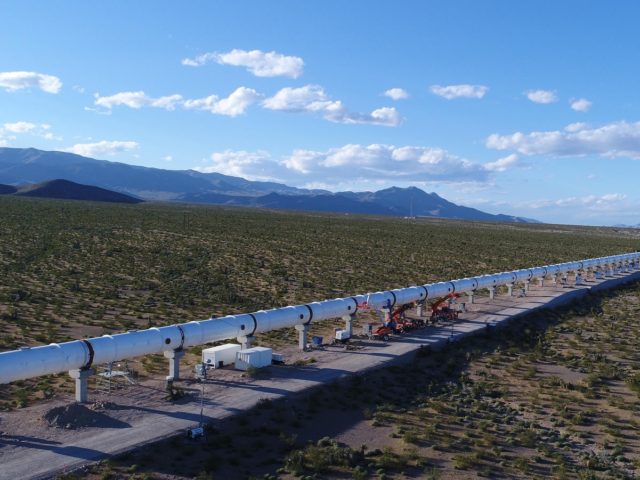Hyperloop One may have just killed California’s high-speed rail project, after the company’s 28-foot long aluminum and carbon-fiber production-scale pod hit its first milestone by traveling down a 1,640-foot near-zero-resistance vacuum tube test-track at a speed of 70 miles-per-hour.
The Verge reported that the Hyperloop One (H1) test pod achieved the equivalent of a rocket traveling in the ionosphere about 38 miles above the Earth, or about 5 times higher than the top altitude for a commercial jet.
Although it only took the H1 about 5 seconds to complete the 1,640-foot journey, the closed vacuum tube and unmanned transport pod’s 2G acceleration was flawless. The H1’s next milestone is a 250 miles-per-hour test late this year, and a 100-foot manned test pod in 2018. Hyperloop claims it can build out its system and begin moving commercial passengers and freight at speeds of up to 760 miles-per-hour by 2022.
Hyperloop’s development is sponsored by SpaceX’s CEO Elon Musk, who claims that he can build the Hyperloop One elevated tube system, stations and pods for $6 billion. That works out to a cost of about $11.5 million per mile to cover 381 transits between Los Angeles and San Francisco downtown stations. But due to the almost zero-friction vacuum tube travel, Musk claims a one-way ticket for the 35 minutes trip will cost about $20.
That H1 speed is substantially faster than the Boeing 747-8i — The Queen of the Skies — operated by Air China, Korean Air, and Lufthansa, which holds the top commercial airliner operating speed of 660 miles-per-hour. The 467-passenger configuration’s operating costs are $140 to $580 per passenger-hour, depending on peak and off-peak travel times.
There are three mag lev (magnetic levitation) trains in Asia that float above tracks, and many aerodynamically-shaped bullet trains that travel on tracks. But air friction and fuel consumption limit their maximum operating speeds to about 270 miles-per-hour for freight trains, and about 180 miles-per-hour for passenger trains. Their system costs are about $30 per passenger-hour.
The California High-Speed Rail Authority (CHSR) in 2009 estimated its 510-mile rail system would cost $42.6 billion to build and would achieve operating costs of $15 per passenger hour, based on a 2-hour-and-40-minute one-way trip from Los Angeles to San Francisco.
As Breitbart News noted in March, the build-out costs of the state-run project have escalated to roughly $93 billion, due to the cost of boring through huge mountains and buying up hundreds of miles of private land for the track right-of-way. CHSR had decided that its state-of-the-art bullet trains would travel through Silicon Valley on a “blended” system that includes 60-year old Bay Area Rapid Transit (BART) rails, where commuter trains average speeds 35 miles-per-hour.
Due to the more-than-doubling build-out cost, and the 50 percent increase in travel time, the average CHSR cost-per passenger hour has now spiked to about $40.
Even if the high-speed rail has no more cost overruns or passenger delays, it will never be cost competitive with airlines that advertise dozens of round-trip L.A.-to-San Francisco flights each week.
Hyperloop One’s build-out costs will be a fraction of CHSR’s, because its elevated vacuum tubes will run along the existing rights-of-way on the 5 Freeway from L.A, up the Central Valley, and then across the BART lines to San Francisco.
Hyperloop One has raised $160 million from big venture capital, including 137 Ventures, Khosla Ventures, Fast Digital, Western Technology Investment, SNCF, the French National Rail Company, and GE Ventures.
Hitting its first production-scale milestone means H1 will soon raise huge amounts of cash to finish testing and begin a rapid build-out of a truly low-cost and high-speed rapid transit.

COMMENTS
Please let us know if you're having issues with commenting.